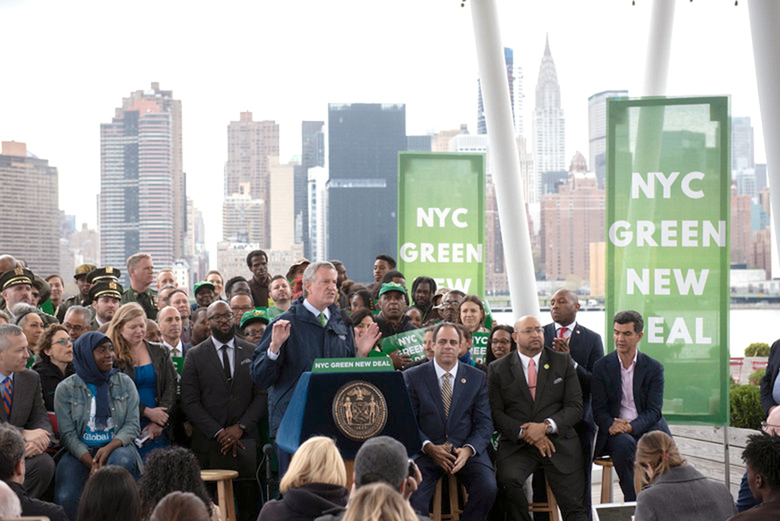27. April 2019
“> –
–
“> –
–
New York Mayor Bill de Blasio presented the “Green New Deal” on April 22, 2019. Image: Michael Appleton / Mayoral Photography
Just in time for “Earth Day”, April 22, the city of New York passed the “Climate Mobilization Act”, also known as the “Green New Deal”. Accordingly, it is planned that buildings with glass facades may only be built under strict conditions in the future. In addition, structural measures must be taken on 50,000 old buildings in order to reduce their CO2 emissions and energy consumption. It is not yet clear what exactly these will look like.
Although the “Green New Deal” initiative presented by New York Mayor Bill de Blasio addresses a lot – from climate neutrality and improving air quality to stopping the opioid epidemic and preventing the displacement of tenants – the media interest is primarily concentrated on what impact it could have on the built environment. The plan contains a few points that should be of particular interest to architects:
- Achieving climate neutrality by 2050 and a 100 percent clean power supply: The city is now pursuing high goals in terms of reducing greenhouse gas emissions. In addition, all electricity is to be generated from green energies in future, which is also expected to create new jobs. Polluters should be asked to pay.
- Ordering a reduction in CO2 emissions from existing buildings: According to de Blasio, measures must be taken on houses with an area of over 25,000 sf (around 2,323 m2) to reduce their energy consumption and CO2 emissions. If this does not happen and no retrofitting is carried out, high fines should be imposed. 50,000 buildings in the urban area would be affected.
- Prohibition of inefficient glass facades. The city will no longer allow (high) buildings with glass facades to be erected unless strict performance guidelines are observed. Designs with excessively large glass surfaces could soon be a thing of the past.
Change of the cityscape?
With the adoption of these three points, the focus is primarily on buildings – especially large ones – in order to achieve a reduction in greenhouse gas emissions. Unsurprisingly, according to studies such as the “OneNYC Report”, these are responsible for two thirds of emissions. Although it is still unclear exactly how the measures to reduce emissions and energy consumption of old buildings are to be exteriorized, many New York politicians believe that these, together with the ban on inefficient glass facades, will certainly change the face of the city. However, it also seems possible that homeowners would prefer to pay fines and architects will develop buildings with glass facades that meet the strict guidelines that have been announced.
An obstacle to compression?
John H. Banks, President of the Real Estate Board New York (REBNY) and the most important lobbyist for the industry in the city, already took the plans under prophylactic fire. He calculated that 50 percent of New York’s buildings (houses with less than 25,000 sf) would not be affected by them. This means, he continued, a preference for smaller objects and makes compression unattractive.
What is undisputed, however, is the need to have more green roofs over urban buildings, commercial buildings, factories and residential complexes. Almost everyone sees their practical benefits (more biodiversity, more plants, fewer heat islands, more efficient drainage of rainwater). But up to now they have not been created enough. Higher tax rebates could be a good incentive here.
–

